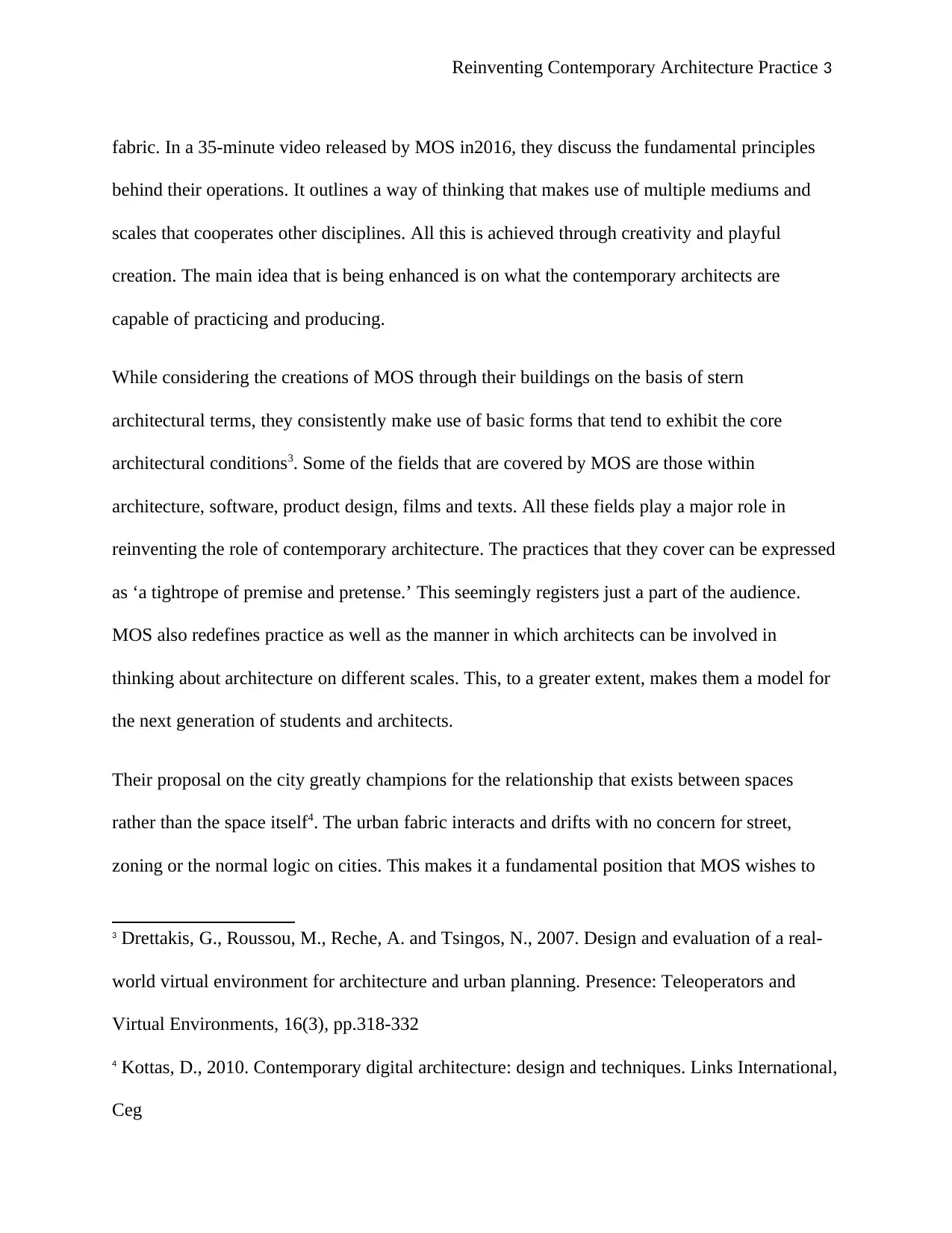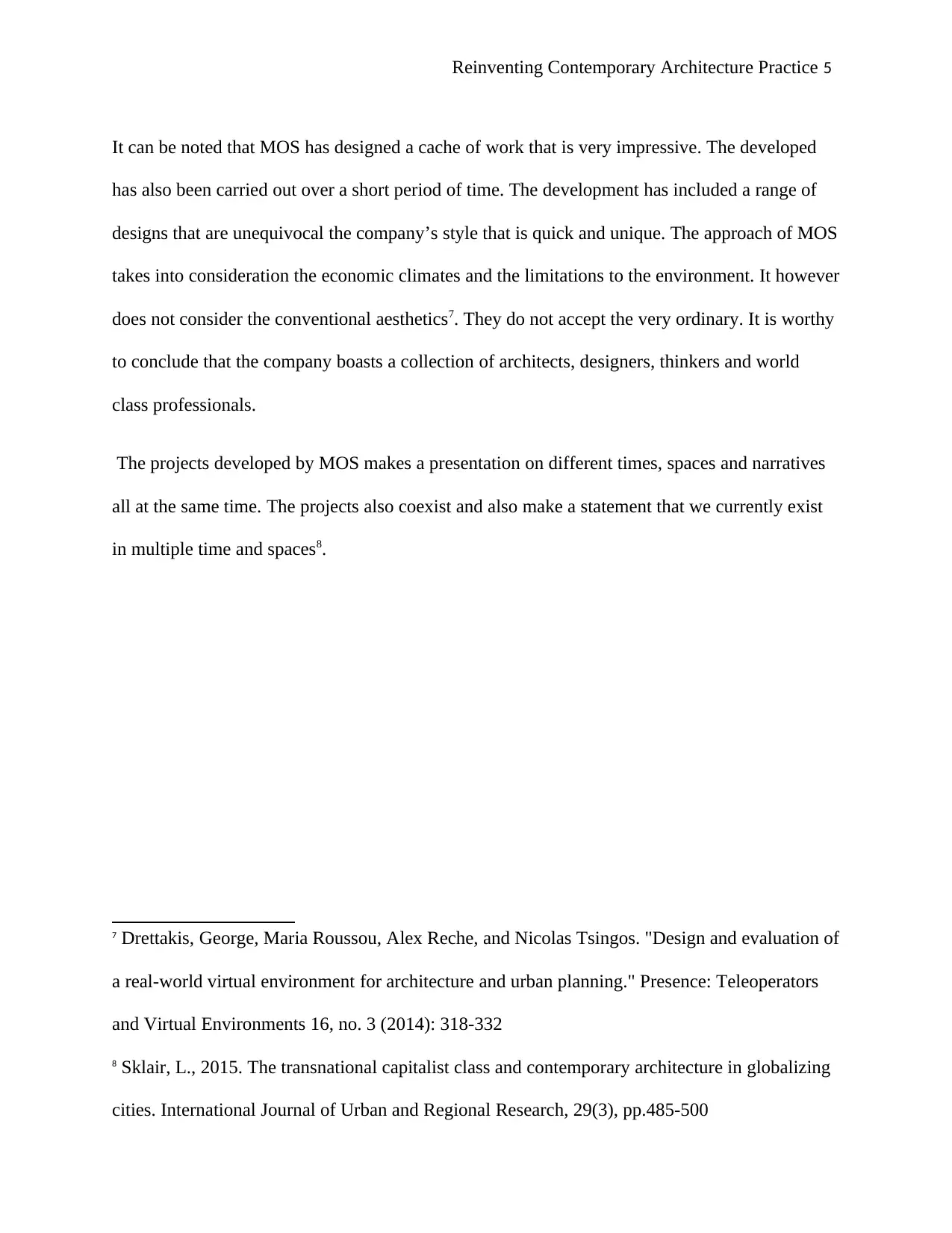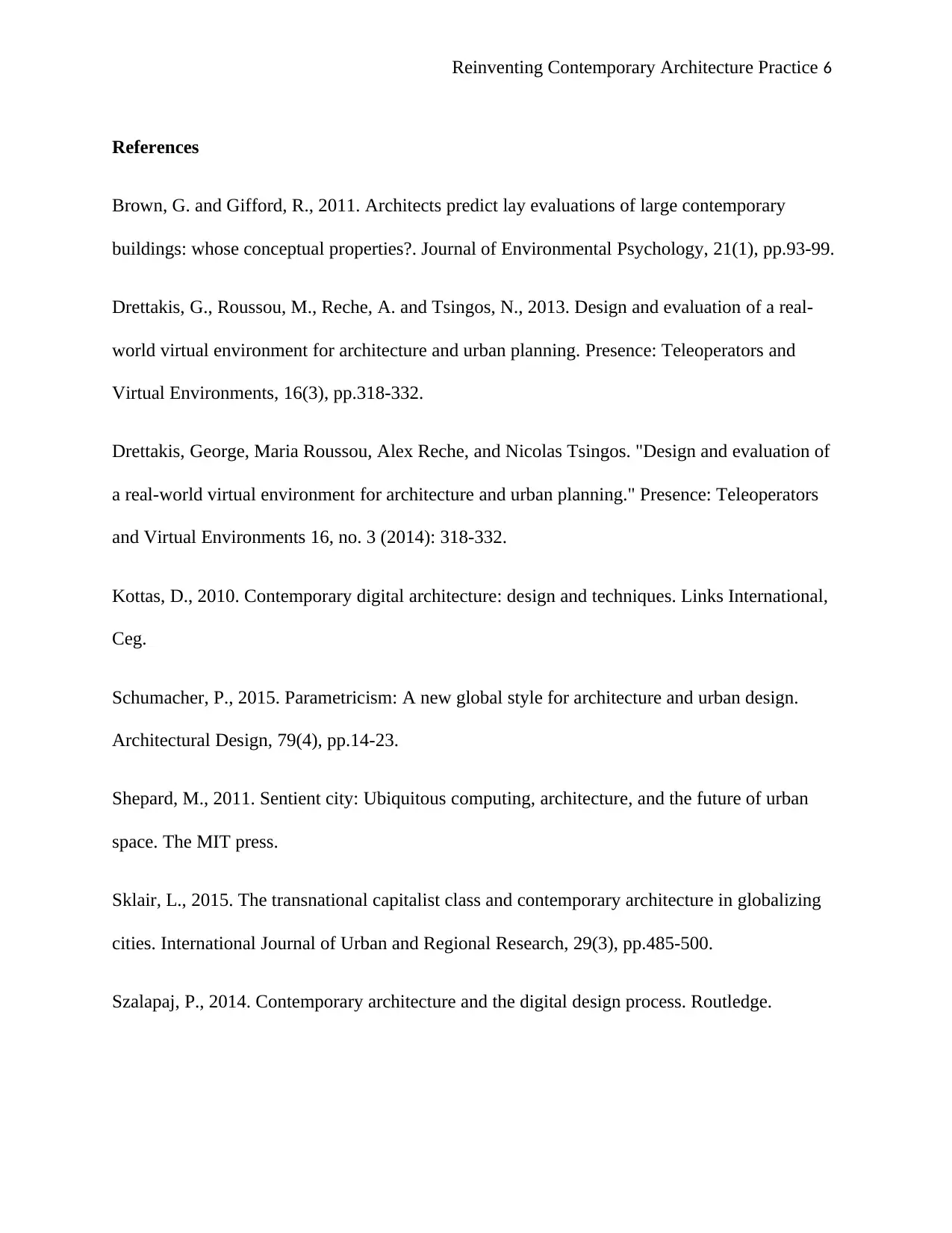Reinventing Contemporary Architecture Practice - UTS Assignment
VerifiedAdded on 2023/06/03
|6
|1549
|69
Essay
AI Summary
This essay explores the reinvention of contemporary architecture practice, particularly in the context of urban design and its relationship to the social fabric. It references a proposal by MOS architects, entitled ‘A Situation Constructed from Loose and Overlapping Social and Architectural Aggregates,’ as a case study for how contemporary architecture can be reinvented. The essay discusses the use of technology, up-to-date building materials, and the importance of functionality over style. It highlights MOS's approach, which incorporates various disciplines such as software, product design, films, and texts, to redefine architectural practice. The essay also touches on the concept of urbanism and how it structures social identity, and concludes by emphasizing MOS's unique style and their consideration of economic and environmental limitations.

Reinventing Contemporary Architecture Practice 1
REINVENTING CONTEMPORARY ARCHITECTURE PRACTICE
By Name
Course
Instructor
Institution
Location
Date
REINVENTING CONTEMPORARY ARCHITECTURE PRACTICE
By Name
Course
Instructor
Institution
Location
Date
Paraphrase This Document
Need a fresh take? Get an instant paraphrase of this document with our AI Paraphraser

Reinventing Contemporary Architecture Practice 2
Reinventing Contemporary Architecture Practice in This Modern Age
Contemporary architecture basically refers to the styles of building that are diverse and also
assert a wide range of influences. It is commonly known as the architecture of the 21st century.
One common tool for the advancement of contemporary architecture is the use of technology as
well as up-to-date building materials. Just as in the case of art, buildings must also welcome a
critical thought1. This may be in the form of visual experience. The buildings should also fulfill
the needs of the end users. Architecture is therefore a perfect combination of aesthetic and
function. The final outcome of any architectural construction should dissolve into a framework
of experience. Buildings are not viewed in the same way as art. This is because they are
constantly used in order to fulfill our day to day activities as well as our wants all at a go, that is,
in shopping, leisure, education and transportation. Contemporary architecture is a movement
meant to embrace new methods of buildings and forms that are on the basis of mainly
functionality rather than style. It is therefore a responsibility for any architecture to ensure that
all their architectural plans and designs abide by the stated objectives2.
In a bid to determine how urban form can maintain a positive correlation to the social fabric, a
proposal by MOS entitled ‘A Situation Constructed from Loose and Overlapping Social and
Architectural Aggregates.’ This was a proposal for the 2016 Biennale. The proposal tends to
give a solution on how best contemporary architecture can be reinvented by the use of social
1 Brown, G. and Gifford, R., 2001. Architects predict lay evaluations of large contemporary
buildings: whose conceptual properties?. Journal of Environmental Psychology, 21(1), pp.93-99.
2 Szalapaj, P., 2014. Contemporary architecture and the digital design process. Routledge.
Reinventing Contemporary Architecture Practice in This Modern Age
Contemporary architecture basically refers to the styles of building that are diverse and also
assert a wide range of influences. It is commonly known as the architecture of the 21st century.
One common tool for the advancement of contemporary architecture is the use of technology as
well as up-to-date building materials. Just as in the case of art, buildings must also welcome a
critical thought1. This may be in the form of visual experience. The buildings should also fulfill
the needs of the end users. Architecture is therefore a perfect combination of aesthetic and
function. The final outcome of any architectural construction should dissolve into a framework
of experience. Buildings are not viewed in the same way as art. This is because they are
constantly used in order to fulfill our day to day activities as well as our wants all at a go, that is,
in shopping, leisure, education and transportation. Contemporary architecture is a movement
meant to embrace new methods of buildings and forms that are on the basis of mainly
functionality rather than style. It is therefore a responsibility for any architecture to ensure that
all their architectural plans and designs abide by the stated objectives2.
In a bid to determine how urban form can maintain a positive correlation to the social fabric, a
proposal by MOS entitled ‘A Situation Constructed from Loose and Overlapping Social and
Architectural Aggregates.’ This was a proposal for the 2016 Biennale. The proposal tends to
give a solution on how best contemporary architecture can be reinvented by the use of social
1 Brown, G. and Gifford, R., 2001. Architects predict lay evaluations of large contemporary
buildings: whose conceptual properties?. Journal of Environmental Psychology, 21(1), pp.93-99.
2 Szalapaj, P., 2014. Contemporary architecture and the digital design process. Routledge.

Reinventing Contemporary Architecture Practice 3
fabric. In a 35-minute video released by MOS in2016, they discuss the fundamental principles
behind their operations. It outlines a way of thinking that makes use of multiple mediums and
scales that cooperates other disciplines. All this is achieved through creativity and playful
creation. The main idea that is being enhanced is on what the contemporary architects are
capable of practicing and producing.
While considering the creations of MOS through their buildings on the basis of stern
architectural terms, they consistently make use of basic forms that tend to exhibit the core
architectural conditions3. Some of the fields that are covered by MOS are those within
architecture, software, product design, films and texts. All these fields play a major role in
reinventing the role of contemporary architecture. The practices that they cover can be expressed
as ‘a tightrope of premise and pretense.’ This seemingly registers just a part of the audience.
MOS also redefines practice as well as the manner in which architects can be involved in
thinking about architecture on different scales. This, to a greater extent, makes them a model for
the next generation of students and architects.
Their proposal on the city greatly champions for the relationship that exists between spaces
rather than the space itself4. The urban fabric interacts and drifts with no concern for street,
zoning or the normal logic on cities. This makes it a fundamental position that MOS wishes to
3 Drettakis, G., Roussou, M., Reche, A. and Tsingos, N., 2007. Design and evaluation of a real-
world virtual environment for architecture and urban planning. Presence: Teleoperators and
Virtual Environments, 16(3), pp.318-332
4 Kottas, D., 2010. Contemporary digital architecture: design and techniques. Links International,
Ceg
fabric. In a 35-minute video released by MOS in2016, they discuss the fundamental principles
behind their operations. It outlines a way of thinking that makes use of multiple mediums and
scales that cooperates other disciplines. All this is achieved through creativity and playful
creation. The main idea that is being enhanced is on what the contemporary architects are
capable of practicing and producing.
While considering the creations of MOS through their buildings on the basis of stern
architectural terms, they consistently make use of basic forms that tend to exhibit the core
architectural conditions3. Some of the fields that are covered by MOS are those within
architecture, software, product design, films and texts. All these fields play a major role in
reinventing the role of contemporary architecture. The practices that they cover can be expressed
as ‘a tightrope of premise and pretense.’ This seemingly registers just a part of the audience.
MOS also redefines practice as well as the manner in which architects can be involved in
thinking about architecture on different scales. This, to a greater extent, makes them a model for
the next generation of students and architects.
Their proposal on the city greatly champions for the relationship that exists between spaces
rather than the space itself4. The urban fabric interacts and drifts with no concern for street,
zoning or the normal logic on cities. This makes it a fundamental position that MOS wishes to
3 Drettakis, G., Roussou, M., Reche, A. and Tsingos, N., 2007. Design and evaluation of a real-
world virtual environment for architecture and urban planning. Presence: Teleoperators and
Virtual Environments, 16(3), pp.318-332
4 Kottas, D., 2010. Contemporary digital architecture: design and techniques. Links International,
Ceg
⊘ This is a preview!⊘
Do you want full access?
Subscribe today to unlock all pages.

Trusted by 1+ million students worldwide

Reinventing Contemporary Architecture Practice 4
take which is by making designs of architecture very responsive just the way clothing is. This is
achieved by making an embedment of the pluralistic approaches to specific framework in the
image5. The proposal is situated above and around the Dequindre cut and makes use of high
density development, low rise, open spaces and arranging frameworks in order to make
connections with the existing conditions that result to a new city fabric.
From the ground level view of the proposal, common spaces can be witnessed scattered all
around the cut. The common spaces famously connect the existing street system to the proposed
community. Instead of just creating new space in the name of making the proposal successful,
MOS makes use of the existing spaces. This idea helps in making strong their principles of
design. The collection of emptied topologies and buildings serves the purpose of an open
framework for someone or anything else to occur6. The ownership is collective. They also work
outside the basis of lots and property. Each and every exterior space is considered a public
space. Every interior space is private space. Activation of social modes is done through intimacy.
The concept of ‘the city is not what it used to be’ is used to express how the city and the people,
who were commonly referred to as subjects are no longer different to one another. This concept
further complicates the definition of the term ‘city’ and ‘place’ due to the growing unclear
milieu. Urbanism has for the past years structured modern social identity thus offering
architecture a façade. However, in this modern era, it is this identity that forms the structure to a
city.
5 Schumacher, P., 2015. Parametricism: A new global style for architecture and urban design.
Architectural Design, 79(4), pp.14-23
6 Shepard, M., 2011. Sentient city: Ubiquitous computing, architecture, and the future of urban
space. The MIT press
take which is by making designs of architecture very responsive just the way clothing is. This is
achieved by making an embedment of the pluralistic approaches to specific framework in the
image5. The proposal is situated above and around the Dequindre cut and makes use of high
density development, low rise, open spaces and arranging frameworks in order to make
connections with the existing conditions that result to a new city fabric.
From the ground level view of the proposal, common spaces can be witnessed scattered all
around the cut. The common spaces famously connect the existing street system to the proposed
community. Instead of just creating new space in the name of making the proposal successful,
MOS makes use of the existing spaces. This idea helps in making strong their principles of
design. The collection of emptied topologies and buildings serves the purpose of an open
framework for someone or anything else to occur6. The ownership is collective. They also work
outside the basis of lots and property. Each and every exterior space is considered a public
space. Every interior space is private space. Activation of social modes is done through intimacy.
The concept of ‘the city is not what it used to be’ is used to express how the city and the people,
who were commonly referred to as subjects are no longer different to one another. This concept
further complicates the definition of the term ‘city’ and ‘place’ due to the growing unclear
milieu. Urbanism has for the past years structured modern social identity thus offering
architecture a façade. However, in this modern era, it is this identity that forms the structure to a
city.
5 Schumacher, P., 2015. Parametricism: A new global style for architecture and urban design.
Architectural Design, 79(4), pp.14-23
6 Shepard, M., 2011. Sentient city: Ubiquitous computing, architecture, and the future of urban
space. The MIT press
Paraphrase This Document
Need a fresh take? Get an instant paraphrase of this document with our AI Paraphraser

Reinventing Contemporary Architecture Practice 5
It can be noted that MOS has designed a cache of work that is very impressive. The developed
has also been carried out over a short period of time. The development has included a range of
designs that are unequivocal the company’s style that is quick and unique. The approach of MOS
takes into consideration the economic climates and the limitations to the environment. It however
does not consider the conventional aesthetics7. They do not accept the very ordinary. It is worthy
to conclude that the company boasts a collection of architects, designers, thinkers and world
class professionals.
The projects developed by MOS makes a presentation on different times, spaces and narratives
all at the same time. The projects also coexist and also make a statement that we currently exist
in multiple time and spaces8.
7 Drettakis, George, Maria Roussou, Alex Reche, and Nicolas Tsingos. "Design and evaluation of
a real-world virtual environment for architecture and urban planning." Presence: Teleoperators
and Virtual Environments 16, no. 3 (2014): 318-332
8 Sklair, L., 2015. The transnational capitalist class and contemporary architecture in globalizing
cities. International Journal of Urban and Regional Research, 29(3), pp.485-500
It can be noted that MOS has designed a cache of work that is very impressive. The developed
has also been carried out over a short period of time. The development has included a range of
designs that are unequivocal the company’s style that is quick and unique. The approach of MOS
takes into consideration the economic climates and the limitations to the environment. It however
does not consider the conventional aesthetics7. They do not accept the very ordinary. It is worthy
to conclude that the company boasts a collection of architects, designers, thinkers and world
class professionals.
The projects developed by MOS makes a presentation on different times, spaces and narratives
all at the same time. The projects also coexist and also make a statement that we currently exist
in multiple time and spaces8.
7 Drettakis, George, Maria Roussou, Alex Reche, and Nicolas Tsingos. "Design and evaluation of
a real-world virtual environment for architecture and urban planning." Presence: Teleoperators
and Virtual Environments 16, no. 3 (2014): 318-332
8 Sklair, L., 2015. The transnational capitalist class and contemporary architecture in globalizing
cities. International Journal of Urban and Regional Research, 29(3), pp.485-500

Reinventing Contemporary Architecture Practice 6
References
Brown, G. and Gifford, R., 2011. Architects predict lay evaluations of large contemporary
buildings: whose conceptual properties?. Journal of Environmental Psychology, 21(1), pp.93-99.
Drettakis, G., Roussou, M., Reche, A. and Tsingos, N., 2013. Design and evaluation of a real-
world virtual environment for architecture and urban planning. Presence: Teleoperators and
Virtual Environments, 16(3), pp.318-332.
Drettakis, George, Maria Roussou, Alex Reche, and Nicolas Tsingos. "Design and evaluation of
a real-world virtual environment for architecture and urban planning." Presence: Teleoperators
and Virtual Environments 16, no. 3 (2014): 318-332.
Kottas, D., 2010. Contemporary digital architecture: design and techniques. Links International,
Ceg.
Schumacher, P., 2015. Parametricism: A new global style for architecture and urban design.
Architectural Design, 79(4), pp.14-23.
Shepard, M., 2011. Sentient city: Ubiquitous computing, architecture, and the future of urban
space. The MIT press.
Sklair, L., 2015. The transnational capitalist class and contemporary architecture in globalizing
cities. International Journal of Urban and Regional Research, 29(3), pp.485-500.
Szalapaj, P., 2014. Contemporary architecture and the digital design process. Routledge.
References
Brown, G. and Gifford, R., 2011. Architects predict lay evaluations of large contemporary
buildings: whose conceptual properties?. Journal of Environmental Psychology, 21(1), pp.93-99.
Drettakis, G., Roussou, M., Reche, A. and Tsingos, N., 2013. Design and evaluation of a real-
world virtual environment for architecture and urban planning. Presence: Teleoperators and
Virtual Environments, 16(3), pp.318-332.
Drettakis, George, Maria Roussou, Alex Reche, and Nicolas Tsingos. "Design and evaluation of
a real-world virtual environment for architecture and urban planning." Presence: Teleoperators
and Virtual Environments 16, no. 3 (2014): 318-332.
Kottas, D., 2010. Contemporary digital architecture: design and techniques. Links International,
Ceg.
Schumacher, P., 2015. Parametricism: A new global style for architecture and urban design.
Architectural Design, 79(4), pp.14-23.
Shepard, M., 2011. Sentient city: Ubiquitous computing, architecture, and the future of urban
space. The MIT press.
Sklair, L., 2015. The transnational capitalist class and contemporary architecture in globalizing
cities. International Journal of Urban and Regional Research, 29(3), pp.485-500.
Szalapaj, P., 2014. Contemporary architecture and the digital design process. Routledge.
⊘ This is a preview!⊘
Do you want full access?
Subscribe today to unlock all pages.

Trusted by 1+ million students worldwide
1 out of 6
Related Documents
Your All-in-One AI-Powered Toolkit for Academic Success.
+13062052269
info@desklib.com
Available 24*7 on WhatsApp / Email
![[object Object]](/_next/static/media/star-bottom.7253800d.svg)
Unlock your academic potential
Copyright © 2020–2025 A2Z Services. All Rights Reserved. Developed and managed by ZUCOL.





